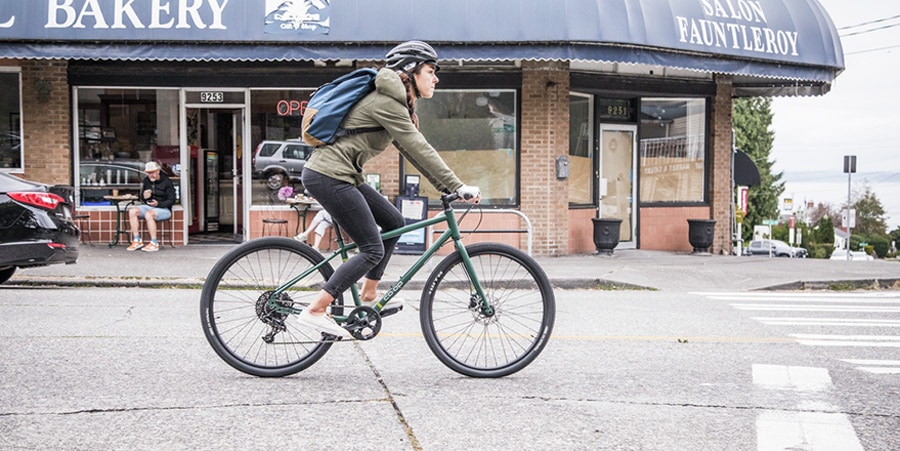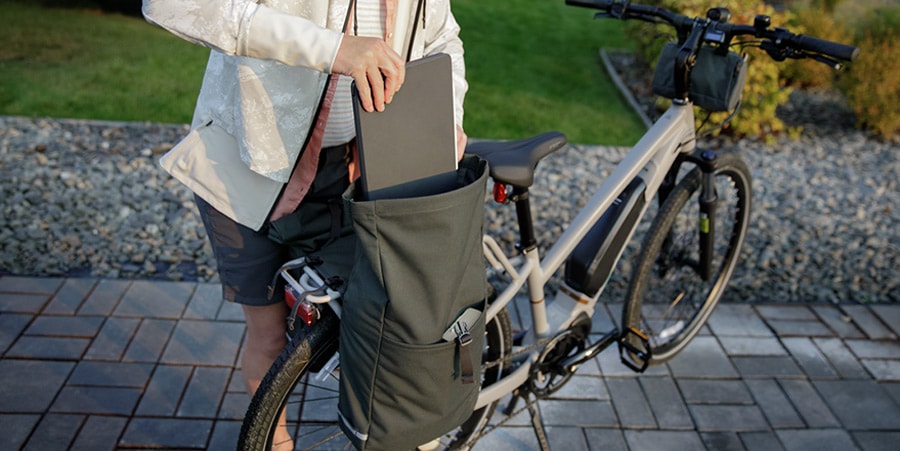The price of gas. Health and fitness. Fun. Climate change. There are a lot of good reasons for considering bike commuting as an alternative to your car or even mass transit. To get started, you'll want to consider the bike itself plus a variety of gear options that range from essential to convenient. Here are the things to consider for your next commute.
Choosing a Bike for Your Commute

Know Your Priorities
There's no one kind of bike that's best for commuting. It depends on the terrain, the road conditions, the distance, your personal preference and aesthetics. (Hey, we all like to look good, even while pedaling.) The best bike is the one that you like and will ride.
If you already have bike that you haven't ridden in a while, consider taking it to your nearest REI bike shop for a tune-up or to get advice on what you might need to get it in good working order. If you're considering buying a bike for commuting, here are some things to consider:
- Pros: Based on mountain-bike geometry for a relaxed, upright riding position; alloy frame to minimize weight and maximize energy efficiency; often includes rear rack for panniers or a rack trunk.
- Considerations: May not be as rugged as a mountain bike nor as sleek and light as road bike, so you may need a second bike to enjoy either activity.
- Pros: Good commuting choice for those who need to tackle hilly routes, long distances or the logistics of arriving sweaty at your destination. Can carry heavier loads, making easy to haul groceries or run errands during the day. Smooth, comfortable ride.
- Considerations: Heavier weight makes it more challenging to carry up stairs if storage is a consideration; battery requires charging.
- Pros: Lightweight; narrow tires for reduced rolling resistance; fast; suitable for any length of commute.
- Considerations: Road tires tend to be more susceptible to flats; stiff ride is energy-efficient but not as relaxed and comfortable as some alternatives; not suitable if your commute involves riding on unpaved trails or singletrack.
- Pros: Wider tires for a stable, well-balanced ride; flat handlebars for more comfortable, upright riding position that's more visible in traffic; tires are generally more resistant to flats than road tires; adapts easily to any road or off-road commuting conditions.
- Considerations: Heavier, with greater rolling resistance than road bikes (this is more of a factor on long commutes).
What to Wear to Bike Commute

It's Good to Be Comfortable
You don't need special clothes to be a bike commuter. But if your commute is long, investing in some cycling shorts with chamois padding can make the ride a lot more pleasant. Bike liner shorts are popular options because they can be worn underneath your street or work clothes; they provide padding while helping to control sweat. Shorts are available in both the sleek, body-hugging road-racing style or the looser, laid back mountain-bike style. A moisture-wicking top is also a good choice. It will help keep you cool and dry when it's warm.
Protect Your Head
Never get on your bike without first strapping on a helmet. Even the most experienced rider can take an unexpected spill. Your helmet can be the difference between a few scrapes and bruises and serious, even life-threatening, injuries.
A helmet liner adds a welcome layer of warmth on chilly rides. It can also create a more comfortable fit for your helmet, keep sweat from rolling into your eyes and provide UV protection.
Plan on Getting Wet
For most commuters, an investment in a waterproof, breathable jacket and pants and neoprene shoe covers makes the ride to and from work a whole lot more comfortable (and healthier). Even fair-weather-only bike commuters should be prepared for a surprise rain shower.
Hands and Feet
Cycling gloves are not a fashion statement. The padded palms absorb road vibration, reducing hand and arm fatigue. They also protect your hands from abrasion in the event of a fall. In warm weather, fingerless gloves are a popular option. As the weather cools, switch to full-finger styles, including waterproof and insulated versions, when needed.
The type of shoes you select depends on the kind of bike you're riding, and whether it has clipless pedals, toe clips or platform pedals. If you have platform (flat) pedals, you can wear whatever shoes you want. Shoes designed for cycling have rigid or semi-rigid soles. This ensures that the energy of your leg stroke drives cleanly through the pedal. (Soft-soled shoes diffuse that energy, contributing to foot and leg fatigue.)
For more information, see the REI Expert Advice article, How to Choose Bike Shoes.
Eye Protection
Depending on weather and commute times, your ride to work may present different light conditions than your ride home. Sunglasses with interchangeable lenses let you adjust accordingly and maintain an optimal view of the route ahead. Lighter-colored lenses help to enhance contrast when its cloudy, and in the low light of dawn or dusk. Darker polarized lenses reduce sun glare and eye strain.
Essential Commuting Gear

Tire Repair Gear
If you ride long enough, you're eventually going to have a flat tire. So learn how to change or repair a tube and always carry the following:
- Spare tube or tubes (and/or patch kit)
- Mini-pump (or CO2 cylinder)
- Tire levers
- Cycling multi-tool (with Allen wrenches)
For tube-changing instructions, see the REI Expert Advice article and video, How to Fix a Flat Tire on Your Bike.
Packs and Panniers
Unless your commute is short and your work environment casual, you may need to carry a set of clothes, maybe a towel and any work-related materials that come and go with you. Your gear-carrying options:
Daypack:
- Pros: Maximum capacity; the best choice if you ride more than one bike (it goes with you, without any hardware); least stressful on bike and riding mechanics; available in hydration models.
- Cons: Can increase your sweating, though some styles are designed to minimize this; messenger-style packs don't always stay behind you, causing shifting weight. Carrying weight on your body, as opposed to the bike frame, can increase fatigue.
Handlebar bag and rack trunks:
- Pros: Easily accessible; they keep back and shoulders free from any weight.
- Cons: Limited capacity; handlebar bags can obstruct other accessories, such as a light, bike computer or GPS unit. Carrying weight on the front can effect the handling of the bike.
Panniers:
- Pros: They keep back and shoulders free from any weight. You can take them with you into the office. They'll generally keep the weight of your stuff lower on the center gravity of the bike for more stability.
- Cons: Smaller capacity than backpacks; added weight and stress on rear wheel; can impede your pedal stroke; combination of rear rack and pannier bags increase wind drag.
Underseat Bag:
- Pros: A convenient way to carry spare tube, patches and repair tools. For minimalist commuting, add your keys, phone and wallet; larger bags can hold a lightweight rain shell; decreased wind drag.
- Cons: Very limited capacity; can't carry a change of clothes or other items; pump would need to be attached to bike separately.
Lights and Reflectors
Lights (front and rear) are invaluable at night and advisable on rainy days or other marginable-light situations. For short distances along brightly lit streets, an economical light system may serve your needs. But if you travel a greater distance or where lighting is poor or variable, then a high-quality halogen system is well worth the investment.
In addition to front, back and side reflectors, put a reflective band on your helmet and wear reflective clothing. The more visible you are in low-light conditions, the safer you'll be.
Bike Locks
Unless your workplace provides secure storage for your bicycle, carry a lock. If your bike is easily accessible to the public, choose a high-quality U-style lock that's difficult to pick or cut. Consider a locking skewer, a device that secures your wheels to your frame, so you can only worry about locking the frame up. Another security measure: Register your bike and serial number with a registry such as the nonprofit Bike Index.
Fenders
Along with waterproof outerwear (jacket and pants), fenders are a must for anyone commuting in wet weather. The alternative is to get to work with a dirty wet stripe up your back. Choose the kind that fully covers the tires. You and your bike will stay cleaner and drier.

